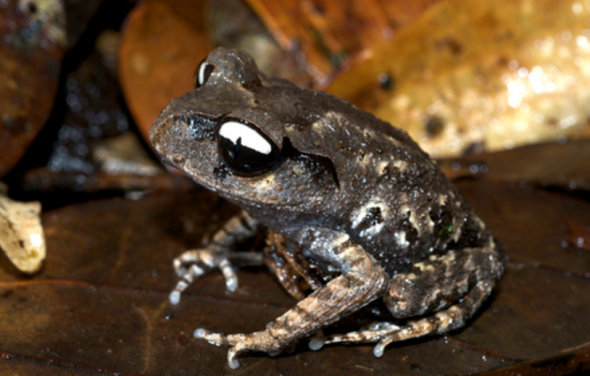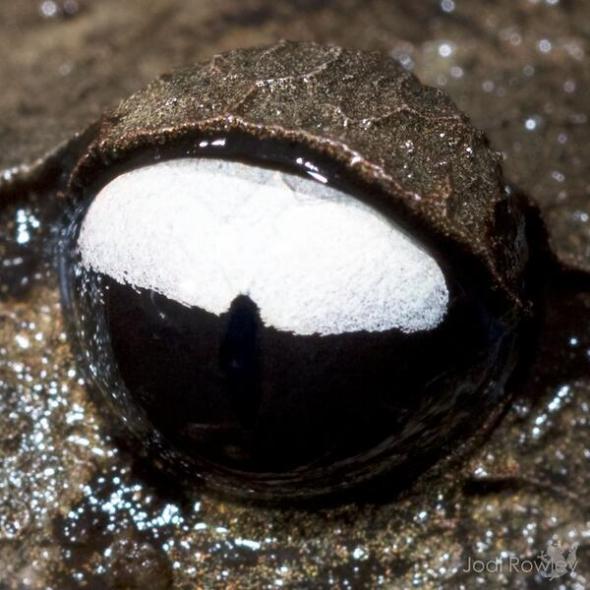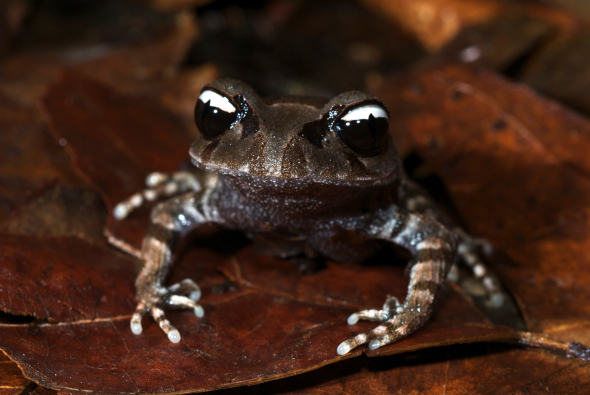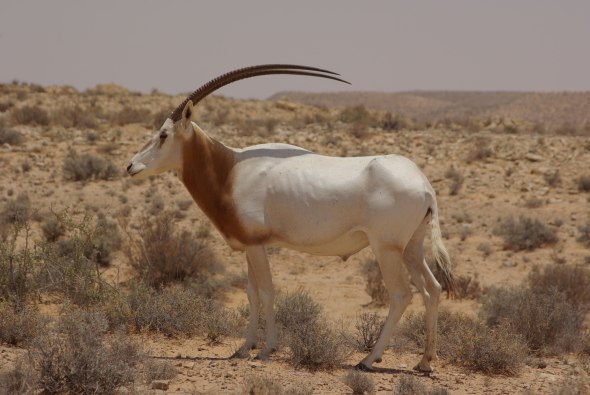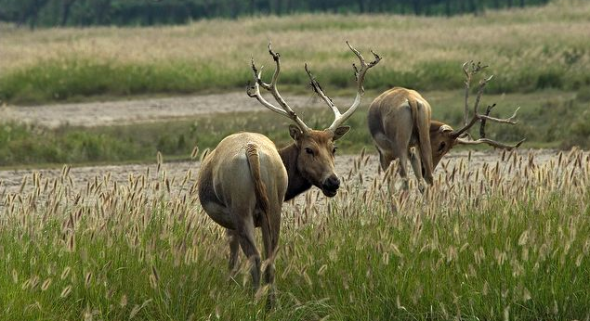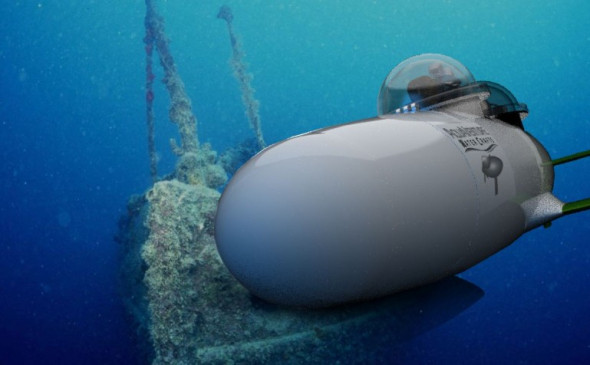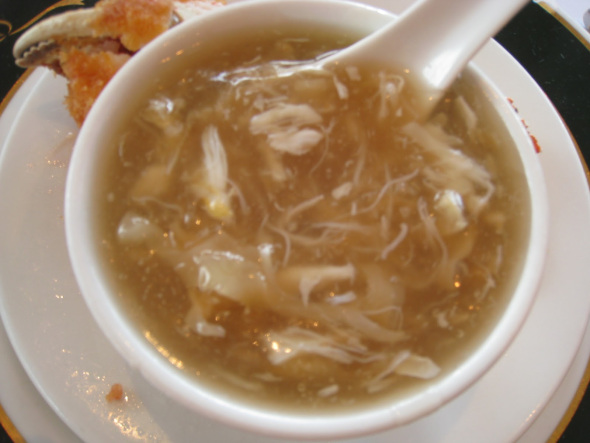ENDANGERED SPECIES MONDAY | SPOTTED SEAHORSE FACING EXTINCTION.
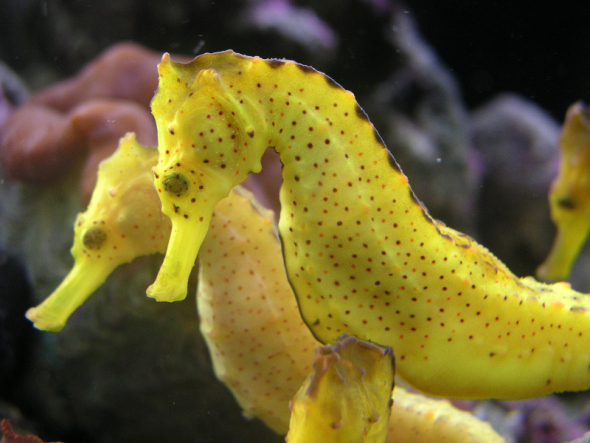
ENDANGERED SPECIES MONDAY | HIPPOCAMPUS KUDA
Once a common site within our oceans, the spotted seahorse (common seahorse) is facing extinction. The largest threat known is use and trade within the Traditional Chinese Medicine culture. As of 2015 its estimated that some twenty million (20 million) seahorses are used within the Traditional Chinese Medicine trade. (Photographer unknown).
Known in Mandarin as Hai Ma seahorses are believed to cure a wide spectrum of ailments and diseases and generally help to improve health. There is no evidence that I can locate to prove seahorses can improve human health in anyway shape or form. T.C.M practitioners have alleged seahorses can cure anything from asthma, arteriosclerosis, incontinence, impotence, insomnia, thyroid disorders, skin ailments, broken bones, heart disease, throat infections, abdominal pain, sores, skin infections.
Broken bones? Now that is about as ridiculous as it gets, impotence and broken bones are not illnesses but more physical complaints of which consuming seahorses is about as effective as pouring boiling hot water onto a third degree burn. A study in Taiwan located some fifty eight (58) sea horses from Taiwanese T.C.M vendors. A total of eight (8) different species were located. Seven (7) were listed as vulnerable, while one (1) was listed as endangered.
Source: http://www.jfda-online.com/article/S1021-9498(13)00043-4/abstract
The species listed as endangered was Hippocampus capensis commonly known as the Knysna seahorse (pictured below). The remaining seven (which doesn’t include the species pictured above) are scientifically identified as Hippocampus algiricus, Hippocampus comes, Hippocampus histrix, Hippocampus kelloggi, Hippocampus kuda, Hippocampus spinosissimus, and Hippocampus trimaculatus. If we include the species above - Hippocampus kuda this makes a total of eight (8) listed as vulnerable, and one (1) listed as endangered equating to nine (9) in total nearing extinction.
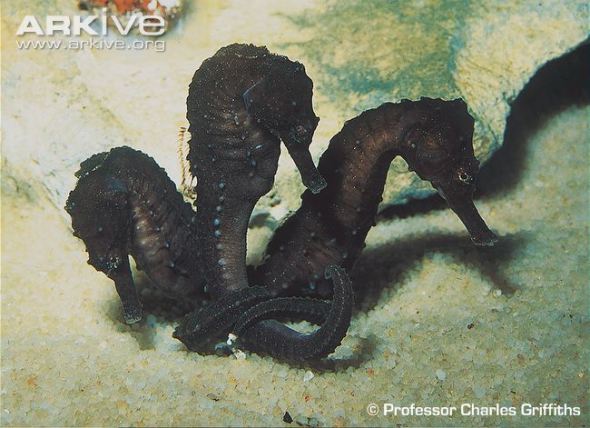
Image: Knysna seahorses | Credits Professor Charles Griffiths
Its quite possible there could be many more species of sea horses that haven’t been listed on the International Union for the Conservation Of Natures Red List [IUCN]. Hippocampus kuda was identified back by Dr Pieter Bleeker (July 10, 1819, Zaandam – January 24, 1878, from The Hague) whom was a Dutch medical doctor, ichthyologist, and herpetologist.
He was famous for the Atlas Ichthyologique des Orientales Neerlandaises, his monumental work on the fishes of East Asia published between 1862 and 1877. I don’t state this often however am going to repeat oneself again. Every single species of animal I’ve written about identified from the (1800’s) has almost all but gone extinct or are at least on their way towards extinction. Another pattern I have found is that many animals and plants used within the (T.C.M) trade were being used thousands of years ago - long before non-Asian travelers identified them. When the species are eventually identified - individual specie populations begin declining!
Since 1996-2003 the common seahorse has been listed as vulnerable, populations are declining very fast, furthermore there was little mentioned about the species at CoP17 in Johannesburg, South Africa; a country that is responsible for a large proportion of seahorse harvests. These harvests are legally shipped from South Africa into Asia, yet large numbers of seahorses are decreasing in South Africa.
I.A.R.F.A Environmental Crime Investigators located one legal trader identified as NGWABE TRADING that hosts a supplying ability of TWO HUNDRED METRIC TONS a month. When we inquired where these seahorses are harvested from, and the species caught we were not given a straightforward answer. NGWABE TRADING was though able to supply us with seahorses that have paperwork (all allegedly legal and above-board.) Yet we’re losing the vast majority of our seahorses. Furthermore I am very suspicious as to whether all of these seahorses are being harvested legally.
Two hundred metric tons per month is no different to two hundred metric tons of sand, cement, or rocks. On questioning the fishing company which I myself do suspect illegal poaching is going on here, many of these seahorses are dry traded to Asia. We’re talking big bucks too. So if this trade was restricted, or even banned, its likely South Africa would lose her seahorses in a matter of years, because legal farming operations wouldn’t be allowed if trade bans came into place. Meaning poaching would increase on a wide scale to supply Asia’s appetite for pseudo medicines.
Source: http://southafrica.tradekey.com/dried-sea-horses.htm
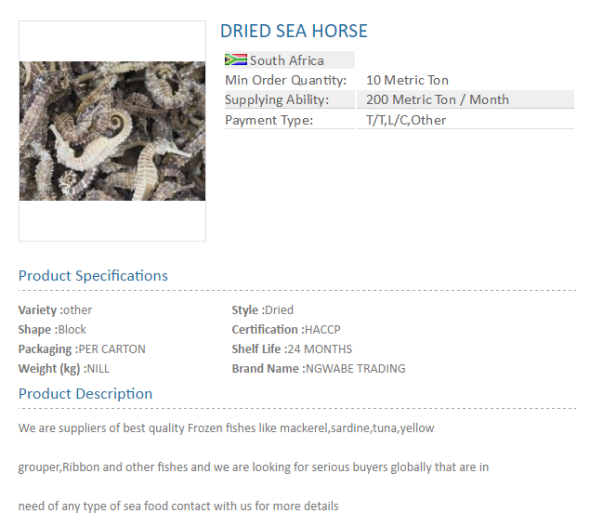
Image: One of many legal online seahorse/fish traders trading to Asia.
Seahorses are also used as an aphrodisiac and to facilitate childbirth in the T.C.M trade. As much as I want to disbelieve this, there is unfortunately “some scientific evidence” that does prove to a degree consuming a regular fish diet can improve sexual behavior within humans; however helping to conceive I am somewhat skeptical about. Sources are cited below for your information from the scientific community.
Source 1: http://www.pbs.org/wgbh/nova/seahorse/vincent.html
Source 2: http://www.acupuncturetoday.com/herbcentral/sea_horse.php
Between twenty (20) and forty (40) million seahorses are allegedly harvested every-year for the T.C.M trade, however if we go on the amount of trade originating from South Africa - its obvious that by the ton load this number is seriously under-quoted. If I myself was purchasing the minimum ton load of ten (10) tons per month - that would easily equate to over twenty (20) and forty (40) million seahorses per annum based on twelve (12) months.
So I think its safe to say we’re looking at possibly hundreds of millions rather than the claimed IUCN stats. I must also note that the spotted seahorse is listed on Appendix II, and to date we will never really know how many seahorses remain within their endemic range, or how many are illegally harvested?
The common seahorse in question which is the species harvested the most for the T.C.M trade is endemic to the following regions: American Samoa (American Samoa); Australia (Northern Territory, Queensland); Bahrain; Cambodia; Fiji; French Polynesia; Hong Kong; India; Indonesia; Japan; Kuwait; Malaysia; Micronesia, Federated States of ; Mozambique; New Caledonia; Pakistan; Papua New Guinea; Philippines; Saudi Arabia; Singapore; Solomon Islands; South Africa (KwaZulu-Natal); Taiwan, Province of China; Tanzania, United Republic of; Thailand; Tonga; United States (Hawaiian Is.); and Viet Nam.
Endemic ocean locations are: Indian Ocean – western; Indian Ocean – eastern; Pacific – western central; Pacific – northwest; Pacific – eastern central.

Image: Dried Seahorses for sale, China | Credits David Fleetham
THREATS
Common threats are cited above in more detail. Major threats though are listed below for your immediate attention:
Hippocampus kuda is threatened by damage to its habitats from coastal development and destructive fishing practices. Land-based activities such as coastal construction can diminish seagrass beds and mangroves while leading to increased pollution and siltation in surrounding marine waters. For example, in Malaysia Hippocampus kuda numbers declined due to an extensive port development around the Pulai Estuary that destroyed large tracts of seagrass meadow.
Fishing methods such as trawling result in substantial damage to seagrass beds globally, and especially in the Indo-Pacific. The decline in and fragmentation of the species’ habitats throughout its range indicates possible declines in populations in addition to those caused by fisheries.
All seahorse species have vital parental care, and many species studied to date have high site fidelity, highly structured social behaviour, and relatively sparse distributions. These life history parameters often make species susceptible to exploitation as has been demonstrated for a number of species, including seahorses. Although seahorses also have some traits, such as small body size, fast growth and high fecundity, that may confer resilience to exploitation pressures.
Due to the mode of spawning exhibited by Hippocampus kuda (ovoviviparous brood pouch male parental care), fecundity is comparatively low compared to non-brood pouch spawning fishes and therefore its capacity for population growth is more limited than other species. As a result of the lack of broadcast spawning of pelagic eggs, dispersal of potential recruits is limited. Additionally, given the limited swimming abilities of seahorses, it is highly unlikely that rescue effects would occur from adjacent populations.
Concluding: I am somewhat concerned about the species future survival. CITES is allowing use and trade however those countries that are listed under the convention are allegedly strictly regulated and monitored - I don’t call ten tons per month from one South African company strict regulation. Countries that are importing/exporting must prove they have permits, however I don’t quite understand how this area of monitoring is working - which it clearly isn’t as the seahorse trade is colossal within many Asian countries and South Africa too.
Hippocampus kuda is listed as vulnerable in the National Red Data Books of Singapore and Thailand, and endangered in the Red Data Book of Viet Nam. In France it is illegal to import seahorses under the name H. kuda.
The future is bleak unfortunately and with trade so fanned out, and from what I have seen on my visits to Asia (increasing) I do honestly believe we’re going to be reporting extinctions in the ‘very near future.’ To date there are thirty two (32) identified species of seahorses. Ecologically, they are important in food chains, consuming tiny fish, small shrimp, and plankton, and being consumed by larger fish (such as tuna and rays) and crabs. So if we lose the seahorse we lose yet another vital source of food for endangered tuna species, rays, crabs, and even whales (Etc.)
Source: http://www.newworldencyclopedia.org/entry/Seahorse
Thank you for reading and please share to create awareness and to improve education.
Dr Jose C. Depre.
Environmental, Botanical & Human Scientist.
www.speakupforthevoiceless.org
Can hunting lead to Species Extinction?
Its a topic that we see spoken about within many animal rights and conservation debate forums, can hunting lead to species extinction? The answer is yes hunting can if not monitored lead directly to species extinction.
The many arguments that quote Cites can help stop species from extinction is not really valid. Cites - Convention on International Trade of Endangered Species does not cover the entire globe.
To date there are a total of one hundred and sixty member states (2013) that are bound by the Cites agreement. So in not so many words hunting can be (restricted) however this doesn’t mean that the member states have to agree with what Cites and other member states call for. Cites was established back in the early 1970’s of which has seen many species of animals and plants preserved. One must remember though that hunting is not the real threat to animals, humans are via over populating that leads to mass habitat fragmentation in many ways. Increased farming, urbanization and depletion of natural resources such as wood have had quite a profound affect to many species of plant and animal.
Case Study #1
Identified in 1826 by Cretzschmar - Oryx dammah.
(Extinct within the wild)..
O. dammah
The Oryx dammah is only extinct within the wild. However, 14,636 km away the Oryx dammah is not extinct on US ranches?, 14,636 km on a private farm in Texas these adorable mammals are trophy hunted. One would think that the farm would actually create a captive breeding program to reintroduce species of O. dammah back in the wild of Northern Africa.
Back in the 1960’s a global captive breeding program was launched when it was finally documented that hunters had literally over hunted the species into extinction. At the same time the African black and white Rhino was bordering extinction however won a reprieve, sadly even they are no longer safe bordering tipping point.
In 2005 a captive breeding assessment showed around some 1,500 individuals of O. dammah within captivity. From 2000-2007 the species was formally identified as completely extinct within the wild. In Chad and Niger it was estimated that a mere five hundred individuals were known to still be living within the wild from 1985. Scimitar horned oryx (common name) is regionally extinct within Algeria, Burkina Faso, Chad, Egypt, Libya, Mali, Mauritania, Morocco, Niger, Nigeria, Senegal, Sudan, Tunisia and the Western Sahara.
Hunters can agree or disagree. The evidence is clear today as it was back in the mid-1980’s when the species was formally assessed as (critically endangered).. Hunters are responsible for pushing species of mammal whether it be the Lion or the O. dammah into extinction. What really concerns International Animal Rescue Foundation’s conservation team is that environmental departments and enforcement agencies were fully aware many species of animals are threatened from human selfishness. Cites was not aware as the treaty was only drawn into practice back in the early 1970’s. Had the Convention on International Trade of Endangered Species that hosts some 160 member states been made aware of the plight of the O. dammah its quite possible they’d still be living within the wild.
Environmental departments on the African continent knew the O. dammah populations were being seriously depleted. So did international agencies. The O. dammah could have been taken into a secure captive breeding program way sooner than the 1960’s and/or protective secure parks established and manned to secure the species within the wild.
Over-hunting and habitat loss, including competition with domestic livestock, have been reported as the main reasons for the extinction of the wild population of Scimitar-horned oryx. Hunters still to this very day propagate unproven data stating the O. dammah is still pretty much alive within the wild. You’ll find that most of these hunters are either cattle ranchers that have never visited our Mama Africa or keyboard hunters that take facts from various sources outdated or unproven.
International Animal Rescue Foundation - Africa located seven ranches inside of the United States that allows tropical hunting of the O. dammah. One ranch we contacted we asked if they would be willing to ship out to Africa a dozen O. dammah for breeding yet we was informed the cattle were only hunted for trophies. Even with money talking not one ranch was willing to comply. (Please note we do not own a captive breeding facility)…
Cattle Ranches in Texas sell for hunting O. dammah Yearling Heifer/Bull priced at $800.00USD, cows as $1,100.00USD and bulls up to 36 inches at $1,300.00USD.. All included - to hunt sets you back a staggering $3,250.00.
Regardless of what hunters state there has been no definite evidence of the survival of this species in the wild for more than 15 years. Yet speak to a few Texan hunters and they’ll inform you otherwise. Sporadic reports of animals sighted in Niger and Chad have never been substantiated, despite extensive surveys dedicated to detection of Sahelo-Saharan antelopes carried out in Chad and Niger in 2001-2004.
It is sadly a fact that hunting whether it be trophy hunting or hunting for bush-meat has contributed to the extinction of this species within the wild. Any hunter that states no species of animal has ever been pushed to extinction within the past twenty years other than the Dodo and Tasmanian Tiger are bare faced uneducated liars that lack any form of conservationism education as their only type of conservation is keeping numbers down commonly known as “hunting” - Its hardly conserving any form of animal.
Case Study #2
Identified in 1866 by Milne and Edwards - Elaphurus davidianus
(Extinct within the wild)
E. davidianus
This species is listed as Extinct in the Wild, as all populations are still under captive management. The captive population in China has increased in recent years, and the possibility remains that free-ranging populations can be established some time in the near future. When that happens, its Red List status will need to be reassessed.
So here is that hunters (propaganda again) within many debates that we read within Animal Rights and conservation forums. The average hunter still argues that no animal has been pushed to extinction via hunting within the past two decades or less. Back in 1990 the Pere David’s Deer as it is commonly known was listed as (endangered). Cites that was well established back then knew this species of deer was facing extinction so did all member states as well as enforcement agencies and Department of Environments yet done nothing to preserve its status until now.
From 1994 the Pere David’s Deer was re-listed as endangered. From 1996 the species was listed again as (critically endangered). Sometime from 1980-1990 the species was re-listed as completely extinct within the wild of which prompted conservation agencies (only when we’d lost the species in the wild) to then begin a captive breeding program. Thankfully and after much success captive bred numbers have increased to over two thousand individuals. What was the main cause for their extinction within the wild?
The species became extinct in the wild due to habitat loss and hunting. The size of the reintroduced population was only 120 in 1993, although has increased to over 2,000 since that time. Low genetic diversity has been identified as a long-term threat by Zeng et al. (2007) and Yang et al. (2008). It is unclear how much native habitat remains on which E. davidianus can exist in a free-ranging state. Is it possible that the species can be reinstated to live freely within the wild? We believe so however to what extent they can remain (wild) within the (wild) is another story.
Would a reintroduction program of the Pere’s David Deer work though? I the Chief Environmental Officer Dr Josa Depre question this time again regarding many species of “horned” mammal that are currently threatened. So, we take a look at why the species E. davidianus was threatened? Firstly blaming US or any overseas hunters is not primarily to blame here. One only has to look at why the species was pushed into extinction to ascertain whether it is actually practical or even professional to reintroduce the species back into the wild of China from which it is endemic too.
Firstly I do not believe in the current climate of poaching and black market wildlife trade that reintroduction of the Pere’s David Deer is practical. E. davidianus was hunted mainly by Asian hunters legally and illegally. Hunted to extinction within the wild mainly for its fur, skeletons, meat, glands and derivatives. if one researches you’ll locate evidence of the Pere’s David Deer used in (TCM) commonly known as Traditional Chinese Medicine. This particular deer was hunted mostly for its glands and skeleton. Musk is wildly used within the far east as a Traditional Medicine and for the use of perfumes (internationally) that sell for hundreds of dollars. However and as shocking as this may read the Pere’s David Deer was hunted for its skeleton for the production of bone wines that is said to enhance sexual pleasure in both men and women.
However we cannot just lay blame here all on the Traditional Chinese Medicine trade. Hunters from all over the globe hunted the Pere’s David Deer mainly for its large and well formed antlers. Furthermore locals and Asians outside of China also hunted the deer for its meat known to be aromatic and tender.
Populations of the Pere’s David Deer are now increasing within (captivity).. Currently, there are a total of 53 herds of E. davidianus in China. Nine herds have fewer than 25 deer, 75.5% have fewer than 10 deer (Yang et al., 2003). Such a small herd size raise question about the effective population size and health of population genetics, since those herds are isolated and there is no gene exchange. The artificially dispersed E. davidianus herds are similar to a meta-population. The viability of the meta-population depends on the man-made gene exchange process by the managers.
Concerns via the International Union for the Conservation of Nature 2009:
A quarter of all antelope species are threatened with extinction.
The results, compiled by the Antelope Specialist Group of IUCN’s Species Survival Commission, show that out of 91 species of antelope, 25 are threatened with extinction. The status of several species has become worse since the last complete assessment of all antelopes in 1996.
“Unsustainable harvesting, whether for food or traditional medicine, and human encroachment on their habitat are the main threats facing antelopes,” says Dr Philippe Chardonnet, Co-Chair of the IUCN Antelope Specialist Group. “Most antelopes are found in developing countries which is why it’s critically important that we collaborate with local communities there since it is in their own interest to help preserve these animals.”
Five species of antelope are in the highest category of threat, Critically Endangered, including the Dama Gazelle (Nanger dama), Aders’ Duiker (Cephalophus adersi), the Saiga Antelope (Saiga tatarica), Hirola (Beatragus hunteri) and Addax (Addax nasomaculatus). The Scimitar Horned Oryx (Oryx dammah) is already Extinct in the Wild, but there are ongoing efforts to reintroduce it. The Dama Gazelle and Addax are both reduced to tiny remnant populations and highlight the dire situation for wildlife in the Sahelo-Saharan region.
A further nine species are in the next category of threat, Endangered, and another nine are classified as Vulnerable on the IUCN Red List of Threatened Species.
Nearly 70 percent of antelope species are not threatened with extinction and some areas of the world are doing better than others in terms of antelope populations. India, for example, is home to four species of antelope and only one of them is currently regarded as threatened.
“Despite the pressure of living alongside 1.2 billion people, antelopes are doing well in India,” says Dr David Mallon, Co-Chair of the IUCN Antelope Specialist Group. “It is no coincidence that there is very little tradition of hunting in India and gun ownership is rare.”
Overall, populations are stable in 31 percent of antelope species and decreasing in 62 percent of antelope species. The Springbok (Antidorcas marsupialis) a native of southern Africa is the only antelope species with a long-term increasing trend, mainly as a result of the game ranching industry.
Conclusion;
Today I have written this article for the many hundreds of Animal Rights Activists and Conservationists in training that are constantly put down by hunters for being “thick” knowing little about what they are actually debating about. Frankly I could go on and submit here another twelve species of mammal and several species of plants that have gone extinct within the wild caused primarily by human hunters and traffickers. Whether it be hunting for food, hunting illegally for the animal parts trade or trophy hunting the answer to the title Can hunting lead to species extinction even with Cites established is quite rightfully yes. My main beef here is that Cites and Governmental Environmental Agencies are fully aware of the many species of land and aquatic mammal that are facing extinction or seriously threatened within the wild. Yet have done little or nothing at all to conserve threatened species. Hunting does and has lead to many species of plant and animals going extinct. The Lion, Rhinoceros, Pangolin, Cheetah, many species of bird and Sharks even trees are all facing extinction within the wild and its hunters, poachers and traffickers that are all to blame. Whether hunting is legal or not without adequate and professional monitoring “any species of mammal or plant” can quite quickly vanish from under our noses.
While the two species above and some sixty nine species are formally extinct within the wild they are at the moment the very lucky ones. Conservation programs are at their very best helping to conserve the known sixty nine species of animal and plant. However there are a total of eight hundred and twenty eight recognized species of animal, fish and plants that are already extinct.
Extinction Means Forever..
If you would like you a fact a sheet on this article or wish to know more please contact myself or my Senior Environmental Officer at - [email protected].
Dr Josa C. Depre
Environmentalist and Botanical Scientist
Environmentalism chapter 12 - Shark Fin
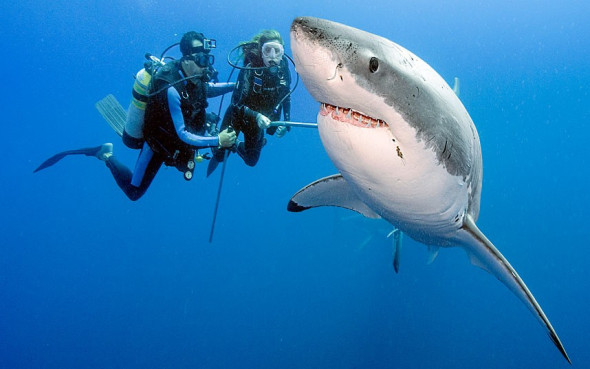
Sharks are one of a kind of Chondrichthyes that have swam the planets oceans for millions of years dating back to the prehistoric realms of the dinosaurs, living through the ice ages, colossal seismic activity that saw many millions of oceanic species wiped out. The shark though a silent stalker and predator remained unscathed.
They were not in any real danger to of traditional Chinese medicine demand or pollution and swam within the oceans with little if any predators, sadly this is hastily no longer factual and the entire species of sharks are being wiped out for a “soup” or medicine used frequently within the Asian medicine market just for tongue and texture.
The species of Shark are not mammalians they are classed as Chordates which is the only unique species of their type separating them from mammals, Chordate are deuterostome animals possessing a notochord, a hollow dorsal nerve cord, pharyngeal slits, an endostyle, and a post-anal tail for at least some period of their life cycles that then develop into the species of which the Deoxyribonucleic acid is programmed to make them into.
Being relatively blind they are agile swimmers yet superb deep sea divers that can smell through an array of senses a drop of blood in the ocean from half way around the world which scientifically is factual although they cannot exactly home in on this being some thousands of miles away there smell is unique from any other form of fish, human or other mammal predator.
The shark noses use ‘smell stereo’ to detect tiny delays no more than half a second long in the time that odours take’s to reach one nostril compared to the other one and that truly is amazing. All species including the deep sea sharks use a combination of directional cues based on scent and the flow of water - to keep them orientated and find what they are searching for.
So the theory that they are human eating man eaters which coincidentally is what the Asians believe hence why they like to consume as well parts the Panthera tigris as in their fake book of counterfeit medicine it states the shark “is a beast and man eater with much energy” that should they consume the shark it will make them a fiery hunter in bed. Its utter nonsense, scientifically untrue, and fairy land tails.
If the delay between the scent reaching one nostril and the other is between a tenth and half a second, the sharks turn their heads to the side where they first smelled the bleeding or anxiously suffering prey such as the squid one of the sharks favorite foods.
If a shark experiences no delay in scent detection or a delay that lasts too long a full second or more they are just as likely to make a left-hand turn as they are to make a right, which makes them rather interesting and a species we must all PROTECT”.
The popular notion that sharks and other animals follow scent trails based on differences in the concentration of odour molecules hitting one nostril versus the other are based on 2010 scientific analyses. It seems that theory doesn’t hold water when one considers the physics of the problem.
Most creatures come equipped with two odour sensors - nostrils or antennae, for example - and it has long been believed that they compare the concentration at each sensor and then turn towards the side receiving the strongest signal.
‘But when odours are dispersed by flowing air or water, this dispersal is incredibly chaotic.’
This recent research on sharks predatory hunting behaviour living has led to findings that has also lead to underwater robots that are better equipped to find the source of chemical leaks, like the oil spill that plagued the Gulf Coast in 2010, 2012 has already seen this research placed to use in many “deep-sea” submersibles now actually using this research to develop state of the technological maritime breakthroughs that have seen many documentaries recorded and sea bed chemical leaks from pipes that are not that easily traceable by other older technologies that can break down at the blink of an eye lid.
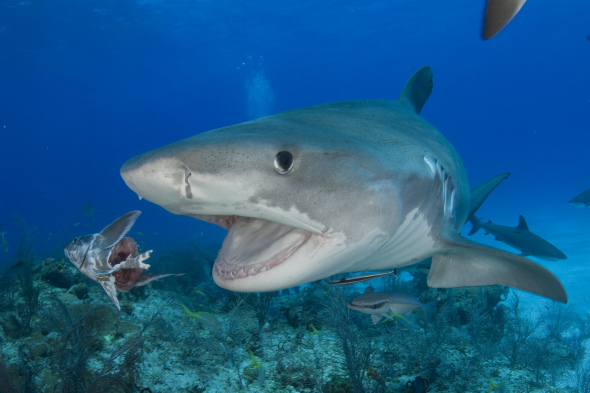
Previous robotic submersibles were programmed to track odours by comparing odour concentrations, and they failed to function as well or as quickly as live animals.
The oil spill in the Gulf of Mexico, and main oil slick was easily visible and the primary sources were easy to locate, smaller sources of Odour-guided robots are an asset for these types of situations with great thanks to the sharks.
The smell organs in the noses of some sharks are able to detect one droplet of blood in one million drops of sea water. They are often attracted to chemicals found in the guts of animals and loiter near sewage outlets so this great research has helped many in the maritime industrial.
Sharks have swam the oceans as far back as we can tell for about 400-500 million years of which there was an estimated 480 species that belong to the subclass of Elasmobranchii, which is in non-scientific jargon cartilaginous fish such as rays which makes them quite different from normal species of fish such are whales that are a sub class of Eutheria distinguished from noneutherians by various features of the feet, ankles, jaws and teeth.
One of the major differences between placental and nonplacental eutherians is that placentals lack epipubic bones although fish don’t have feet, some species that moved from land to waters thousands of years ago have then later evolved in to this “subclass” which the shark species are a subclass of their own from what we know of million year old fossil investigations through archaeology.
Most sharks such as the Carcharodon carcharias, Galeocerdo cuvier, to the Sphyrna lewini are classed as “apex hunters” which basically means they are at the top of the human food chain, they are feared by ourselves even though attacks are rare and just to give you an example of shark attacks verse the bathroom toilet.
Shark attacks for 2011 where 75 global shark attacks, a number closely matching the decade average and the number for 2012 was from what I located to be 62 although that is still to be confirmed surfers and others involved in board sports took the brunt of the attacks, accounting for 60 per cent of unprovoked shark attacks, swimmers 35 percent and divers about 5 per cent.
However the bathroom toilet is quite amusingly odd in 1945, the German submarine U-1206 was sunk after the toilet malfunctioned, and a crewman’s botched repair forced them to the surface killing all on board. King Wenceslaus III of Bohemia was murdered with a spear while sitting in the garderobe (toilet) on August 4, 1306. George II of Great Britain died on the toilet on October 25, 1760 from an aortic dissection. According to Horace Walpole’s memoirs, King George “rose as usual at six, and drank his chocolate for all his actions were invariably methodic. A quarter after seven he went into a little closet. His German valet de chambre in waiting heard a noise, and running in, found the King dead on the floor.” In falling he had cut his face.
Bathing and showering appear to be particularly dangerous. Overall, about two-thirds of accidental injuries happen in the bathtub or shower — which makes sense, because each can become slippery. But many injuries involve the toilet: standing up, sitting down, or using it. (Yes, about 9% of the total injuries were from overexertion.)
Still believe that shark attacks are common and they are “aggressive out of control people eaters” ridiculously untrue please read on. Overall, mishaps near the bathtub, shower, toilet and sink caused an estimated 234,094 nonfatal injuries in the U.S. in 2008 among people at least 15 years old, the Centres for Disease Control and Prevention reported online in its weekly Morbidity and Mortality Weekly Report. And the injury rate rises with age.
Researchers used emergency room data on accidental, nonfatal injuries and some statistical number crunching to reach their conclusions. Their report is full of statistics (which makes it good bathroom reading, if you have 15 minutes and an Internet connection) on the slips, sprains, contusions, fractures and concussions that can happen in the bathroom, to even death.
- About 81% of the injuries were caused by falls (from the bathroom toilet)
- Women were more likely to be hurt than men
- Two-thirds of all injuries occurred in the tub or shower, though only 2.2% occurred while getting into the shower or tub
- Overall, only 1% of accidental nonfatal injuries occurred in the bathroom, but for those 65 and older, 2.5% occurred in the bathroom.
The report can be located here http://www.cdc.gov/mmwr/preview/mmwrhtml/mm6022a1.htm?s_cid=mm6022a1_w how prevailing and odd but very true, so the next time someone states to you that sharks are people eaters and aggressive please remember when you go to the bathroom that your actually “risking your life” Shark attacks though are very unheard of however the reason why they are classed as man eating killing machines is because the press adore to give them a rather bad name.
Such as “GREAT WHITE TORE MAN’S LEG OF” I suppose the headlines “MAN FELL FROM TOILET SEAT AND DIED” just don’t make GREAT reading which is why the press love to make such a mountain out of a molehill over something that could actually be a probing nip which is what a shark will do before “any such attack” takes place. http://mauinow.com/2011/06/07/study-details-hunting-behavior-of-tiger-sharks/
http://www.livescience.com/12783-shark-attacks-hit-10-year-high.html shark attacks on humans only hit a ten year high from recent accident and emergency reports gained from”2011” from all global hospitals. Extraction from the report states;
“Scientists investigated 115 alleged incidents of struggles between humans and sharks worldwide in 2010. They confirmed that 79 of these were unprovoked shark attacks on live humans”.
“Unprovoked attacks are ones that occurred with the predators in their natural habitats without human instigation. The other 36 incidents included 22 provoked attacks — such as assaults after divers grabbed sharks — including three cases of sharks biting boats, four incidents dismissed as non-shark attacks, five scavenging incidents of human corpses and two cases where there was not enough information to determine if an unprovoked shark attack had occurred”. Please read the report as it gives scientific reasoning as to why they have attacked more within the 365 day period. http://dsc.discovery.com/sharks/why-do-sharks-attack.html
What does all this have to do with sharks and the species under threat though? Good question as most of this does as of lack of awareness, the fright factor, and then of course traditional Chinese medicine the NUMBER ONE REASON.
There are MORE attacks on sharks than there are on any other species of fish, and now we need to start taking note of this as we are losing these amazing species rapidly due to counterfeit Asian pharmaceuticals and the disgustingly tasting shark fin soup.
I have always been a firm lover of wild and “predatory dangerous” animals such as mammals from the big lion to Tiger’s, reptilians from Python to Crocodile, and marine aquatic species mainly the shark. In 2010 I traveled to Shenzhena bustling rather smog filled sky scraped city that had many restaurants and street quick food fixes mainly selling animal parts to eat of which shark fin was on the menu.

Thousands of Sharks lay dead in a Singapore fishmongers. Within central China it is said by many, and even activists that the sharks are only craved for, for their fins. This is untrue and this picture was taken three days ago in Singapore’s market. The market sells the shark meat and the fins for major profit making Singapore one of the richest Asian islands in the world.
Being a firm lover of sharks and great studier of the species I wanted to see what all the fuss was about and why sharks where being wrenched out of the water like candy from a baby then de-finned and thrown back to the seabed from which they died a slow agonising death from asphyxiation. Being a vegan for thirty years I really couldn’t care at that point as the main objectives was to try this dish to see if this was indeed a great reason why it is used in Asian medicine, to try and ascertain why one of my favorite species of animals was being slaughtered,
The soup smelt repulsively strong and acidic, and when tasting it without almost vomiting, one can only explain that even with a sprinkle of chive that entire first spoon and that being the last, tasted revolting, and more like hot water with the odd lump of shredded fish cuisine within. Oh yes I forgot the tender informed me that it would make me fit and strong even though I already was in 2010 being a healthy vegan for over 30 years.
https://www.facebook.com/SingaporeFoodRecipes
DISGUSTING AND BLOODY CRUEL - THIS IS ONE RESTAURANT THAT NEEDS BOYCOTTING
The soup did nothing, and there was no magical dragon like hallucinogenic that gave me the power of a thousand men. “Shark fin soup does not under any circumstances improve erectile dysfunction (not that I tried), enhance muscle power, to even warding of any diseases/illness that I actually picked up from visiting the shite hole city of smog and environmental pollution, it does nothing and has no proven health qualities at all. The one spoon fall of fowl tasting crap was enough to show to me that one of the most majestic creatures on earth was being slain for “monetary gain” and not any magical belief. Utterly unbelievable.
Chinese Shark Fin soup is a “luxury” food served (mainly) at banquets, weddings, parties and cultural masses, however it’s killing the species of and rapidly. The Chinese claim “The shark fins provide texture while the taste comes from the other soup ingredients. The soup originated centuries ago during the Ming Dynasty.
However demand for the soup has increased as income levels of Chinese communities worldwide have risen. International concerns over the sustainability and welfare of sharks have impacted consumption and availability of the soup. So because the Asian consumers require “texture” to their soup then sharks have to be slaughtered in their thousands. There is such thing as we croutons or (toasted bread) that add more texture to this pile of watered down crap which contains one of my favorite animals.
It is estimated that 100 to 200 million sharks annually are killed for their fins alone that’s seen many species now pushed to the brink of extinction and just to give an insight of how bad a problem this is please view the link http://www.foxnews.com/world/2013/01/04/hong-kong-traders-dry-thousands-shark-fins-on-roofs-to-avoid-scrutiny/
Sharks that are caught and their fins cut off are not always dead when their bodies are thrown back into the sea. Without its fins the shark simply sinks to the bottom of the ocean where it dies. Such a horrible death for such a magnificent creature and diet, the whole entire practice is unethical, environmentally damaging and will cause havoc in the biodiversity predatory hunting circle if we lose our species of sharks.
Shark fins, once they are harvested, are then dried to be sold in markets to individuals and restaurants to be made into shark fin soup and sold to the public (especially tourists) for as much as $350 per bowl! The shark fins don’t even add any flavor to the soup. Chicken or pork are used to flavor, the fins are for texture only.
The shark fin soup industry uses a wide variety of relatively large sharks. The majority of these sharks are now under threat. They are slow to mature and breed sharks give birth to a few live young or lay a small number of large eggs depending on species, rather than produce thousands of eggs at a time in the manner of many bony fish. Large sharks also do not mature until they are several years old. These characteristics mean that shark populations cannot support high levels of exploitation = nearing extinction to species vaporisation for a bowl of lousy fowl tasting soup.
Mackerel Sharks
The order Lamniformes includes some of the best-known and biggest sharks. Among them are the great white shark, the basking shark and the thresher sharks. All these species are targeted for their fins, and all are either endangered or vulnerable. The great white shark, for example, might be the most feared species of shark, especially after starring in the ’70s thriller “Jaws.” However, they are more threatened by humans than humans are by them.
Ground Sharks
Carcharhiniformes is another order boasting well-known sharks, such as the bizarre looking hammerheads, whose fins command high prices. The order also includes the family of requiem sharks. These are sharks are your typical sharks, with streamlined bodies and sharp teeth. Tiger sharks, bull sharks and the spinner sharks, which jump out of the water, are all requiem sharks, and they are all taken for their fins.
Dogfish
The order Squaliformes includes all the sharks known as dogfish, the bramble sharks and the rough sharks. They are generally small, benthic, seabed-dwelling sharks that lay eggs and reproduce relatively quickly. Their fins are not of much value, although these animals are often targeted for their meat. The tails of some species of dogfish are used for cheap versions of shark fin soup.
Of the five remaining orders of sharks, carpet sharks, bullhead sharks, angel sharks, frilled sharks and saw sharks, few species are used for shark fin soup. They are mostly small sharks, with small or undesirable fins, and they are not valuable in the shark fin market. Some species, notably the critically endangered angel sharks and the whale shark — a species of carpet shark and the largest fish in the world — are targeted for their meat or oil, but not the fins.
If we don’t take urgent notice now and demand that CITES Convention on International Trade in Endangered Species of Wild Fauna and Flora take more action and demand that law enforcement cease this repulsive and degrading trade then we will see an ocean without any sharks that will unfortunately create a massive aquatic biodiversity nightmare in the aquatic hunting food chain.
Sharks eat many prey, these prey need to be naturally controlled to preserve OTHER species of smaller aquatic marine fish, and should the shark numbers carry on dwindling at massive proportions then we are heading for a global catastrophe.
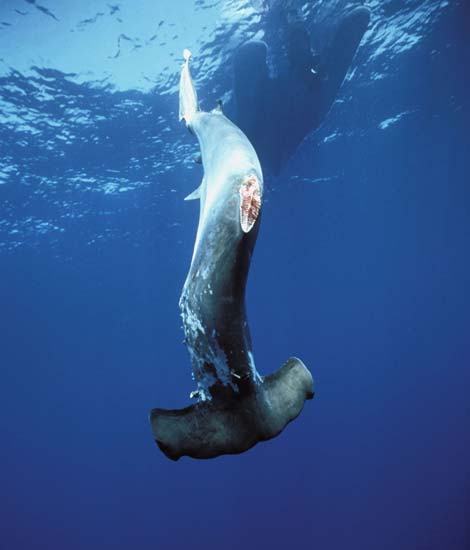
THE SLAUGHTER HAS TO END NOW - PLEASE TAKE IMMEDIATE ACTION AND NEVER GIVE UP HOPE
http://www.hongkong-companies.com/wo-loong-ho-sharksfin-company-limited-b1v6/
https://www.facebook.com/pages/Shark-Fin-Chinese-Bistro-Pensacola-FL/269850188099?fref=ts
PLEASE DEMAND CITES TAKES MORE ACTION NOW BEFORE MARCH OF THE FOLLOWING SPECIES LISTED ABOVE AND BELOW.
Mackerel Shark
Ground Shark
Dog fish
Bullhead shark
Angel Sharks
Frilled Sharks
Lemon Sharks
Saw Sharks
Hammer Head Shark
Reef Shark
PLEASE CONTACT / DEMONSTRATE / PETITION / - 33 DAYS LEFT BEFORE COP 16TH MEETING
CONVENTION ON INTERNATIONAL TRADE IN ENDANGERED SPECIES OF WILD FAUNA AND FLORA;
CITES Secretariat
International Environment House
11 Chemin des Anémones
CH-1219 Châtelaine, Geneva
Switzerland
Tel: +41-(0)22-917-81-39/40
Fax: +41-(0)22-797-34-17
Email: [email protected] (email them hard to get a response)
CONTACT IUCN (International Union for Conservation Nature)
IUCN Conservation Centre
Rue Mauverney 28
1196, Gland, Switzerland
Opening hours: 8:00 to 17:30 Monday to Friday (except Swiss public holidays).
Phone: +41 (22) 999-0000
Fax: +41 (22) 999-0002
Dr J C Dimetri V.M.D, B.E.S, Ma, PhD , MEnvSc
Please support our fundraiser for Benue http://fnd.us/c/3PFe2
Kami ingin mengingatkan orang-orang yang mengirimkan pesan yang tidak diinginkan bahwa situs Anda akan menutup jika Anda tidak berhenti.
We wish to remind all that visit that should you spam “your sites and the server sending to individual registering shall be reported with IP shut down regardless of whom you are” we take spamming seriously and we advise you to cease now.
CHINA STATED IN 2010 AND 2011 THAT THEY WHERE GOING TO BAN CIRCUSES AND THE DOG AND CAT MEAT TRADE (LIES)
ANOTHER ASIAN GOVERNMENTAL LIE - MEDIA FALL FOR THEIR LIES - CHINA CANNOT EVEN REMOVE THE RHINOCEROS HORN OR IVORY THIS VIDEO BELOW IS JUST A PRIME EXAMPLE TO SHUT ACTIVISTS UP - THEY WILL CARRY ON AND STILL IMPORT..
11 months ago CNN stated that China was going to ban SHARK FINS - What China meant was (they where going to hide them from activists which is a common lie from Asia) video taken over three ago.. How coincidental.

